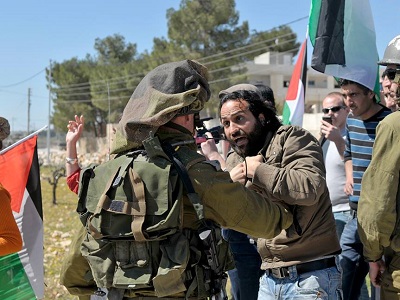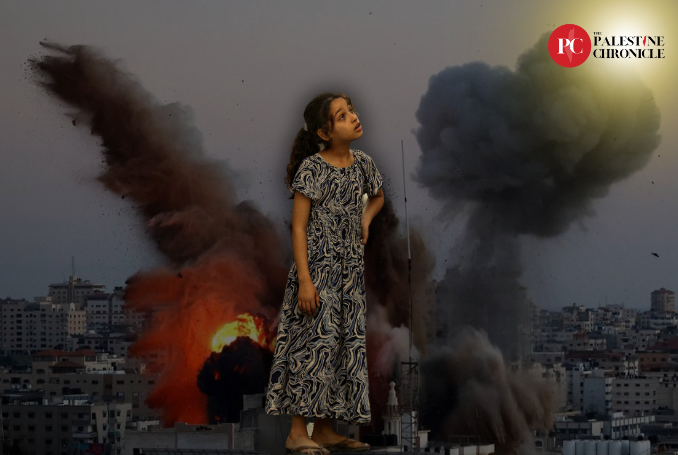
By Ebbe Bertelsen
In the winter months of 1987 a popular uprising erupted in Palestine. In what is known as the First Intifada, the Palestinian people rebelled against twenty years of occupation of the West Bank and Gaza Strip and forty years of apartheid, racial discrimination and humiliation in Israel. For six years mass demonstrations, strikes and university protests swept the country. Within these six years the iconic images of stone throwing boys facing military tanks went around the world. Haidar Eid is an active member of the Palestinian campaign for academic and cultural boycott of Israel and a professor of English Literature and Cultural Studies at al-Aqsa University in Gaza; he explains the significance of the First Intifada:
“Until the First Intifada the Palestinian question was completely marginalized in the international community. The uprising shattered the myth that Israel has the most moral army in the world. Here we had the world’s fourth strongest military literally breaking the bones of Palestinian children.”
In the last years of the Intifada secret negotiations began between the leadership of the Palestinian Liberation Organization (the PLO) and the Israeli Prime Minister Yitzhak Rabin. This process ended with a famous handshake on the lawn of the White House and the signing of what are known as the Oslo Accords. For Haidar Eid the signing of the Oslo Accords in 1993 was a political hijacking of the popular uprising:
“Unfortunately the right wing leadership of the PLO hijacked the outcome of the First Intifada. They thought they had no other option than to negotiate. They had an ideology of defeat, working around the idea that we should accept the West Bank and Gaza Strip as a future Palestinian state, even though these areas only compromise 22% of historical Palestine.”
The consequences of the Oslo Accords were, according to Eid, devastating for the Palestinian resistance for at least a decade. Two interlinked processes, which Eid terms as NGO-ization and Oslo-ization drained the Palestinian liberation movement and created the idea that, the two-state solution is the only feasible way to move forward. The greatest misunderstanding of the Oslo Accords was the framing of Israel and Palestine as two equal states fighting a territorial battle. It was no longer a question of how Palestine could be liberated from a settler-colonial oppressor but rather of the conditions under which Israel would accept an independent Palestine. Eid explains this dramatic shift:
“The Oslo Accords were part of a process of convincing the slave of his own enslavement. Oslo was a process of coming to accept the white master and ultimately defending his right to enslave the native!”
The original plan of the Oslo Accords was to establish a Palestinian Authority and within an interim period of five years for Israel, to gradually hand over responsibilities. The West Bank was divided into three distinct areas: A, B and C. Initially the Palestinian Authority had civil responsibilities in area A, which permitted them to have municipalities, police forces etc. These quasi-state institutions did however turn out to be purely symbolic, as the Palestinian Authority has remained completely powerless. More than 60% of the West Bank is still treated as area C, where Israel has absolute military and civil control. The PA has no bearing on whether Israel chooses to demolish a village or cut electricity for an extended period. Nor does it has any say on the free movement of humans or goods within the West Bank and is obliged to “security coordinate” with Israel. Many Palestinian and Israeli intellectuals, including Eid, compare the creation of the Palestinian Authority to the Bantustans of South Africa. The main function of the Bantustans in South Africa and the PA in Palestine is to manipulate the public and perhaps more importantly the international community into believing that there is actual movement towards independence. The glass palaces of the PA in Ramallah are there to give the illusion of a real state with real institutions.
The Oslo Accords also redefined the Palestinian people. There are a total of around 11 million Palestinians in the world; the Oslo Accords were however only concerned with the approximately 4.5 million living in the Occupied Territories. The status of the around five million Palestinian refugees living in barely habitable camps around the Middle East and the 2.5 million internally displaced Palestinians was neglected in the negotiations.
Inside the borders of Israel 1.3 million Palestinians are living as second-class citizens in an apartheid system. The acceptance of the two-state solution as a desirable outcome is in effect an abandonment of the right of return and an acceptance of a permanent division of the Palestinian people. Eid says:
“I believe that the two state solution is a racist solution par excellence. The two state solution is envisioning two states based on racial segregation. The essence of the Palestinian struggle is the refugees right to return. The refugees cannot return to 22% of historic Palestine.”
Oslo-ization was therefore a process that created divisions among the Palestinian people and transformed a revolutionary wave into apathy. The second process, which drained the resistance in the years following 1993, was the NGO-ization. Since the signing of the Oslo Accords the number of Western founded NGOs rose dramatically especially in the West Bank. Despite what might be the best intentions the NGOs have not served the Palestinian cause, as Eid clarifies:
“There are two premises for working with a Western NGO: firstly you have to forget about your revolutionary past, and secondly you have to accept the idea of a two-state solution.”
Western NGOs are not talking about the refugees’ right to return or the liberation of Palestine. NGOs are working within the framework of an occupation and are focusing on “state building” rather than liberation. Many people who were at the forefront of the First Intifada were incorporated into these NGOs during the 90’s and thereby made harmless. At the end of the 90s it became clear to many people that the Oslo process was not moving forward and in 2000 the accumulated frustrations turned into a second uprising:
“The Second Intifada happened when the Palestinian people reached the moment of truth and the moment of truth came when they realized that the USA never would give them a sovereign, independent Palestine.”
During the first days of the uprising it became clear that this second wave of intensified resistance had a much more violent nature than the mass demonstrations in the 80s and 90s. During five years of attacks and retaliation around 4,000 Palestinians and 1,000 Israelis were killed. Many have argued that the Palestinian cause lost legitimacy in the eyes of international civil society and have therefore asked Palestinian activists to denounce the use of violence. However, if we continue to use international resolutions as guidelines for our moral standards, the Palestinian people have a right to resistance by the means of the armed struggle. A UN resolution from 1974 makes it clear that any people have the right to resist foreign or colonial domination by the means available to them. Up until the late 1980s many prominent Western leaders regarded Nelson Mandela as a terrorist because he refused to denounce the use of armed struggle. The anti-apartheid movement relied heavily on armed struggle as well as mass mobilization and boycott from the international community. These forms were not mutually exclusive in South Africa; on the contrary they complemented each other. Eid believes that the Palestinians should apply different forms of resistance as well, depending on the historical context. As he explains:
“The effectiveness of different means of resistance depends on the historical moment. There is a huge power imbalance between the oppressor and oppressed right now and I therefore believe that the most effective form of resistance is for the international community to boycott, sanction and divest from Israel.”
Within the last decade Palestinian activists have led an incredible amount of non-violent and cultural resistance in cooperation with activists from the international community. Villages such as Nil’in and Bil’in in the West Bank have continuously held weekly non-violent protests against Israel’s apartheid wall, which stretches 742 kilometers through the West Bank and the expansion of the settlements. In 2009 an initiative called the Gaza Freedom March gathered 1,200 activists in Cairo planning to break the siege of Gaza by foot. The Egyptian authorities prevented them from doing so, but they decided to camp in Tahrir Square to protest. Two years later Gaza hosted, for the first time, the International Festival for Literature. At the moment the BDS campaign is gaining unprecedented momentum: artists, academics and even Western politicians are boycotting Israel and refusing to perform there. These are all valuable forms of resistance, but are not always recognized.
In 1994 the South African people elected Nelson Mandela as president. It took many by surprise that decades of colonial oppression seemed to come to an end. Eid feels confident that the times are changing for the Palestinians as well:
“I strongly believe that we are living our South African moment. We will not wait for the Israelis to change their minds – we will make them change the same way White South Africans changed their mind about Apartheid!”
The situation in Gaza looks dire. The renowned Israeli historian Illan Pappé has described Israel’s policies in the Strip as a “slow genocide.” The humanitarian situation is declining and if the population continues to grow, there will be a humanitarian catastrophe within a decade. In the West Bank, the settlements continue to expand quickly and the small islands of Palestinian land are getting smaller and smaller. The Palestinian Bedouins living in the Negev desert have been threatened with expulsion; this is yet another step in the process of ethnic cleansing and in the refugee camps, people continue to suffer as they have done since 1948. Haidar Eid rounds up and states:
“Palestine and the Palestinian people truly deserve to experience their South African moment of liberation. i.e. equality, freedom and justice.”
-Ebbe Bertelsen is a former peace activist in the West Bank with the International Solidarity Movement and student of political science at Copenhagen University Denmark. In July 2013 he worked with an international media convoy in Gaza. To see more of his work visit click here, and read about the convoy. He contributed this article to PalestineChronicle.com.
– Annamaria Bruni (photographer): During a voluntary project with Palestinian Association AIDA, Bruni found inspiration for her latest work on refugees, Profession: Refugees. In 2013, she participated in the “Welcome to Gaza Convoy”. To see more of her work click here.






The author uses the word “apartheid” too often, as if trying to convince the reader and himself that it is applicable and appropriate. It is niether.
If Israel were truly an apartheid state, there would be no Arab MKs, there would be no Arab owned businesses thriving in Israel. Israeli hospitals would not treat palestinian residents in need of care. Jews would be allowed to pray on the Temple Mount. The examples go on.
Is there discrimination? Yes.
Are there better ways to deal with it on both sides? Absolutely.
But rhetoric such as this does nothing but antagonize.
The standards for identifying apartheid anywhere in the world are found in the international Convention on Apartheid; according to that, Israel is practicing apartheid. The South African government commissioned a study of this subject by an international team of legal scholars, who published a 300+ pp report, concluding that Israel is practicing apartheid AND colonialism, both illegal under international law. See a short article on this at the electronic intifada – put “South African Study” in the search box. Also read two good summaries of that 300+ pp report here: http://www.kairosresponse.org. Look in the drop down list under More Resources, and find Israeli Apartheid Report.